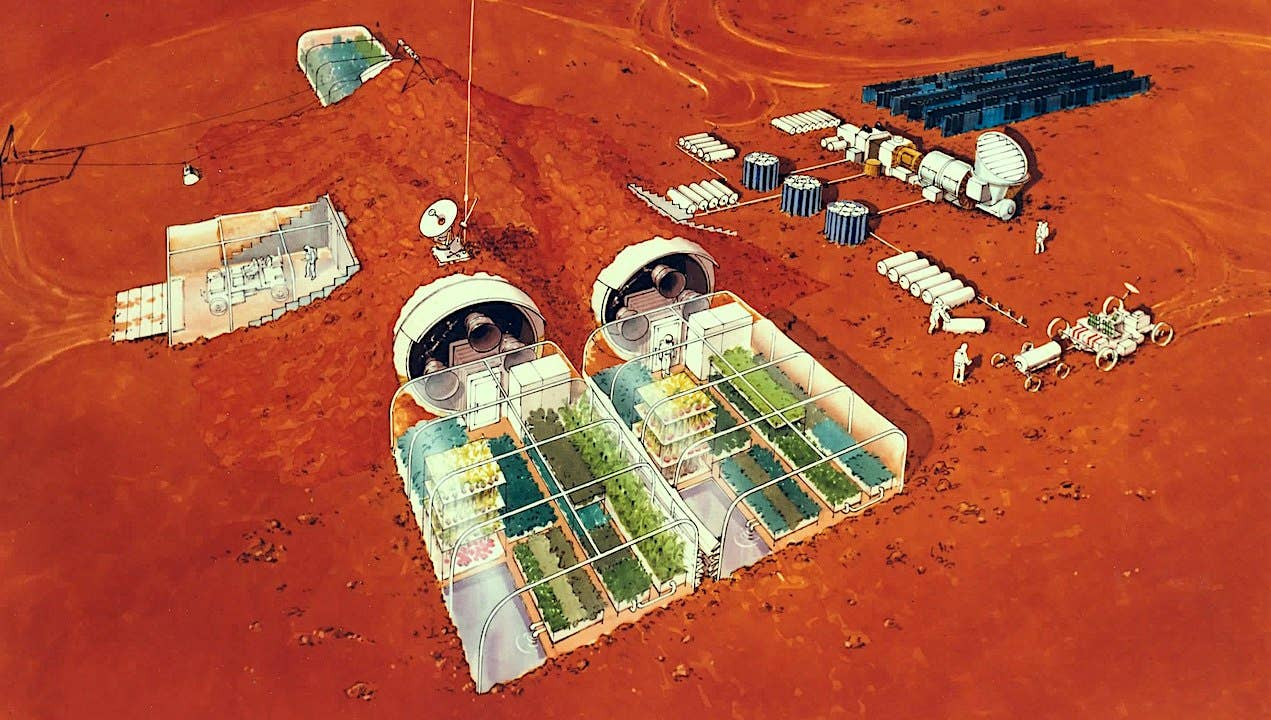Researchers develop sustainable technology to harvest solar power in space
Researchers are working on sustainable technology to harvest solar power in space – which could supplement life support systems on the Mars

[June 13, 2023: Annie Slinn, University of Warwick]
A vision for habitats published by NASA from CASE FOR MARS from the 1980s, featuring the re-use of landing vehicles, in-situ soil use for enhanced radiation shielding, and green houses. A bay for a Mars rover is also visible. (CREDIT: NASA)
Researchers are working on sustainable technology to harvest solar power in space – which could supplement life support systems on the Moon and Mars.
Human deep space exploration is presented with multiple challenges, such as the reliable, efficient and sustainable operation of life support systems. The production and recycling of oxygen, carbon dioxide (CO2) and fuels are hereby key, as a resource resupply will not be possible.
Photoelectrochemical (PEC) devices are investigated for the light-assisted production of hydrogen and carbon-based fuels from CO2 within the green energy transition on Earth. Their monolithic design and the sole reliance on solar energy makes them attractive for applications in space.
In a study published in Nature Communications, scientists assess a new technique which could convert renewable, green energy from outside the Earth’s atmosphere. They are taking advantage of photosynthesis – the chemical process plants undergo every day to create energy – to help the space industry become more sustainable.
Related Stories
The research led by the University of Warwick evaluates the use of a special device known as semiconductor to absorb sunlight on Moon and Mars. It is hoped that the devices could promote Martian life support systems.
These “artificial photosynthesis devices” undergo the same processes which keeps plants alive on Earth – they convert water into oxygen using only sunlight whilst recycling carbon dioxide. These integrated systems have the advantage of directly using solar power and could save on weight on long-term space travels in comparison to traditional systems currently in use on the International Space Station – making space travel more efficient.
There is a need for efficient and reliable energy sources in space to enable the exploration of our solar system. It is hoped that the technology could be installed on the Moon and Mars to harvest green energy to help power rockets and complement life support systems for the production of oxygen and other chemicals as well as the recycling of carbon dioxide.
PEC (photoelectrochemical) energy level diagram, where the device consists of a metal anode and tandem p-n junction photocathode that forms an interface with the electrolyte. b GDE (gas-diffusion electrode)-based CO2 device energy level diagram, where the device consists of a metal anode and buried p-n tandem semiconductor (SC) junction that forms an interface with the GDE. The conduction band (Ecb), valence band (Evb), Fermi level (Ef), Quasi-Fermi electron level (Efn), oxidative overpotential (ηox), reductive overpotential (ηred), and thermodynamic electrochemical potential (Uθ) are given versus the reversible hydrogen electrode (RHE). (CREDIT: Nature Communications)
The insights gained in this study with respect to improving device efficiencies also feed back into their optimization for Earth applications and also provide insights into the performance of traditional solar cells in space.
Assistant Professor Katharina Brinkert, Department of Chemistry, said: “Human space exploration faces the same challenges as the green energy transition on Earth: both require sustainable energy sources. With sunlight being so abundantly available in space, we have shown how this source could be used to harvest energy – much like plants back on Earth – for life support systems for long-term space travel. The technology could provide ample oxygen production and carbon dioxide recycling on both Moon and Mars.”
Simulated MAM spectra as a function of different solar zenith angles, where the solar zenith angle is the distance between a line perpendicular to the planetary surface and the position of the Sun in space. Each MAM spectrum is simulated with all input variables averaged over the course of a Martian year. The terrestrial AM 1.5G and AM 0 spectra are included for comparison. b Yearly averaged, vertical molecular density profiles using the Martian climate database (MCD) feeding into the radiative transfer calculations of the MAM spectra. The y-axis indicates the volumetric concentration (cm–3) of molecules at a given altitude. (CREDIT: Nature Communications)
Associate Professor Sophia Haussener, at the Ecole Polytechnique Fédérale de Lausanne (EPFL), Switzerland, added: “In this study, we finally quantify the potential of such devices for extra-terrestrial use and provide initial design guidelines for their potential implementation.”
The research project was funded by the European Space Agency via the Open Space Innovation Platform – https://ideas.esa.int.
Note: Materials provided above by University of Warwick. Content may be edited for style and length.
Like these kind of feel good stories? Get the Brighter Side of News' newsletter.



